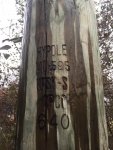171115-0930 EST
Lots of interesting information.
Just went out and looked at my poles, 3 of 5, all three were MBT Co with no date. There are newer tags with 2000 and 2010 markings. MBT stands for Michigan Bell Telephone Co. which became Ameritech, and now AT&T. The MBT poles date from at least 1960, and possibly 1950.
Where I grew up the poles were planted about early to mid 1920s, and I do not believe many have been replaced.
K9MHZ, how is your daughter able to date a pole? Are there date codes on older poles owned by Consumers as distinguished from MBT?
Ingenieur: your long reference was quite interesting. So there are a lot of possible ways for failure to be a direct result of a mechanical failure. I have been wondering if one can consider a dielectric breakdown in some cases to be a mechanical failure rather than electrical.
On my block possibly 2 transformers have failed in the almost 60 years of the installation. There about 30 homes on the block. My 25 kVA transformer was one and it was an oil leak. This transformer was not overloaded, 2 homes with gas for heavy power loads. My average load is 1 to 2 kW. Now have a 50 kVA transformer. Within a reasonable distance of my home I don't believe there is anyone with solar power, and possibly no EV cars requiring chargers. Quite a few Hybrids. There are at least two different 3 phase installations. The 50 kVA transformer is possibly an assumption that there will be EV cars, and/or solar in the future.
What sort of started this thread was that on Friday I am going to take an ESD (Engineering Society of Detroit) tour of the very high voltage lab at Kettering University in Flint. Kettering was originally GMI (General Motors Institute) and is located near the University of Michigan Flint campus.
Back when I was very young and until my late 20s our power cost was 2.5 cents per kWH. It is now about 16 per kWH. By some estimates the value of the dollar over this time has depreciated by a factor of 30. Even if you used 10, and it is definitely worse than 10, our present cost is less than when I was young. This lower real cost was mostly a result increased efficiency of power generation.
To try to keep the cost of electricity low and ignore the infrastructure is a major mistake. Everyone needs their own generator. Where are very large transformers made? How long to make one? How many backups are available?
Looking for information on the Ford Highland Park power plant I did not find what I wanted, but came across this interesting link:
https://en.wikipedia.org/wiki/List_of_power_stations_in_Michigan
.

